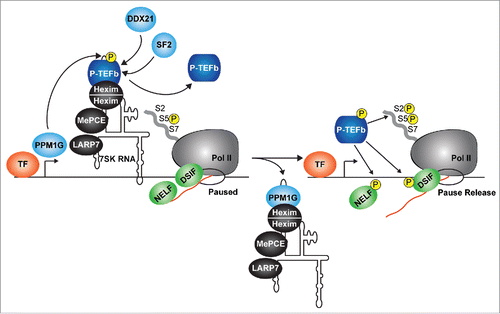Figures & data
Figure 1. The P-TEFb kinase facilitates Pol II pause release. After transcription of a short (> 18 nt-long) RNA chain (red line), the negative elongation factors DSIF and NELF promote pausing by interactions with Pol II and nascent RNA. At this point, the Pol II CTD is in its hypo-phosphorylated form (S5P) by the action of the TFIIH kinase (not shown for simplicity). In response to stimulation, the P-TEFb kinase stimulates the hyper-phosphorylation of the Pol II CTD (S5P and S2P), NELF and DSIF. These phosphorylation events cause the release of NELF from the paused, early elongation complex and transforms DSIF into a positive elongation factor, stimulating the release of Pol II into productive elongation. The arrow denotes the position of the TSS, and the open circle indicates the elongation bubble.

Figure 2. P-TEFb is released from the 7SK snRNP on chromatin. The 7SK snRNP complex (containing P-TEFb phosphorylated in the T-loop, (P)) occupies promoter-proximal regions of genes containing paused Pol II, DSIF and NELF. In response to stimulation, PPM1G is recruited by the canonical transcription factor (TF) to dephosphorylate the P-TEFb T-loop, disrupting its interaction with Hexim-7SK RNA and facilitating its release. Other P-TEFb releasing factors include DDX21 (which directly unwinds the 7SK RNA), and the splicing regulator SF2 (which liberates P-TEFb through interactions with exonic splicing sequences). Through T-loop re-phosphorylation, P-TEFb is re-activated to phosphorylate paused Pol II and the negative elongation factors to promote pause release. The arrow denotes the position of the TSS. TF, transcription factor.

Figure 3. The 7SK snRNP complex is present at the promoters of most Pol II transcribed genes. The 7SK snRNP is recruited onto promoter-proximal regions through KAP1. Here, the P-TEFb kinase is directly released from the 7SK snRNP complex (by the mechanisms described in ) and ‘on-site' activation (Pol II, DSIF, and NELF phosphorylation) occurs at the targeted gene. It remains unclear what the fate of KAP1 and the core 7SK snRNP is once P-TEFb has been released from the promoter-proximal region. TF, transcription factor.

